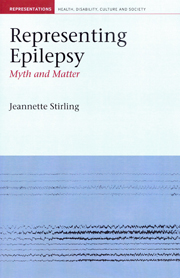Book contents
- Frontmatter
- Contents
- Acknowledgements
- Introduction
- 1 From Hippocrates to Shakespeare and Dickens: epilepsy's entry into ‘the circuit of culture’
- 2 Hystericity and hauntings: the female and the feminised
- 3 Notes from the borderlands: repressing the returned
- 4 The colonies
- 5 Because you're ‘you know. That way’
- Where to next? The ongoing story of epilepsy
- Bibliography
- Index
Introduction
- Frontmatter
- Contents
- Acknowledgements
- Introduction
- 1 From Hippocrates to Shakespeare and Dickens: epilepsy's entry into ‘the circuit of culture’
- 2 Hystericity and hauntings: the female and the feminised
- 3 Notes from the borderlands: repressing the returned
- 4 The colonies
- 5 Because you're ‘you know. That way’
- Where to next? The ongoing story of epilepsy
- Bibliography
- Index
Summary
Since at that second, that is at the very last conscious moment before the fit, he had time to say to himself clearly and consciously: ‘Yes, for this moment one might give one's whole life!’ Then without doubt that moment was really worth the whole of life.
(Fyodor Dostoevsky, The Idiot, 1868, p. 220)Write your story as it needs to be written. Write it honestly and tell it as best you can. I'm not sure that there are any other rules. Not ones that matter.
(Neil Gaiman, Neil Gaiman's Journal, 15 June 2004)This is a book about representations of epilepsy. To a point, it is also about those who experience the condition; or, more accurately, any one of the multiple forms the condition may take. Specifically, though, it is about trade routes between culture and medicine and an unacknowledged traffic between systems of representation that accrete to produce the complex and layered meanings adhering to epilepsy and ‘the epileptic’. Throughout the following pages, I explore the notion that medical stories of epilepsy from the late nineteenth century through to the present are as much forged by the cultural conditions and representational politics of the times as they are by the science of western medicine. It is, perhaps, a bold claim and testing its limits will require multiple border crossings. These border crossings will be made through time, and across discursive boundaries, and will engage with various genres of epilepsy narrative.
- Type
- Chapter
- Information
- Representing EpilepsyMyth and Matter, pp. ix - xxxPublisher: Liverpool University PressPrint publication year: 2010



